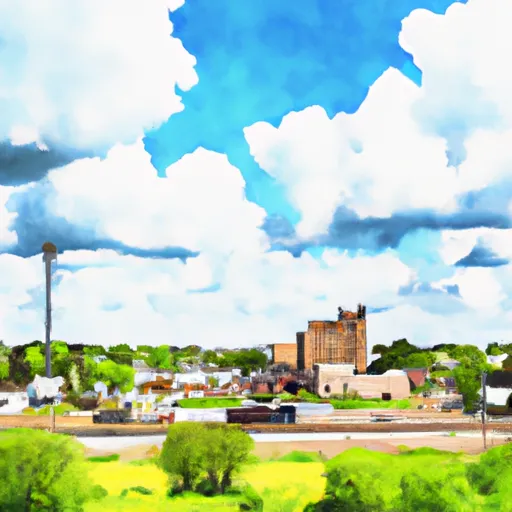-
 Snoflo Premium
Snoflo Premium
Get unlimited access to all our content
With no Ad interruptions! - Start Your Free Trial Login with existing account
Morton
Eden Index
Climate
6.5
•
Recreation
3.7
•
Community
•
Safeguard
3.9/10

Morton, Minnesota is a small town located in Renville County, in the southwestern part of the state. The town experiences a humid continental climate, characterized by cold winters and warm summers. Average temperatures range from around 10°F (-12°C) in January to 80°F (27°C) in July. Precipitation is fairly evenly distributed throughout the year, with an average annual rainfall of about 29 inches (74 cm).
Hydrologically, Morton is situated near the Minnesota River, which influences the town's hydrology. The river provides a source of water and supports various aquatic ecosystems in the region. Additionally, there are numerous lakes and wetlands in the surrounding area, offering opportunities for fishing, boating, and bird-watching. Outdoor enthusiasts can also explore nearby parks, such as the Birch Coulee Battlefield State Historic Site and the Beaver Falls County Park, which provide hiking trails, picnic areas, and scenic views.
In summary, Morton, Minnesota experiences a continental climate with distinct seasons and a moderate amount of precipitation. Its proximity to the Minnesota River and various lakes and parks offers residents and visitors ample opportunities for outdoor recreation and enjoying nature.
What is the Eden Index?
The Snoflo Eden Index serves as a comprehensive rating system for regions, evaluating their desirability through a holistic assessment of climate health, outdoor recreation opportunities, and natural disaster risk, acknowledging the profound impact of these factors on livability and well-being.
Climate Health Indicator (CHI): 6.5
Morton receives approximately
705mm of rain per year,
with humidity levels near 82%
and air temperatures averaging around
8°C.
Morton has a plant hardyness factor of
4, meaning
plants and agriculture in this region thrive during a short period during spring and early summer. Most
plants will die off during the colder winter months.
By considering the ideal temperature range, reliable water supplies, clean air, and stable seasonal rain or snowpacks, the Climate Health Indicator (CHI) underscores the significance of a healthy climate as the foundation for quality living.
A healthy climate is paramount for ensuring a high quality of life and livability in a region, fostering both physical well-being and environmental harmony. This can be characterized by ideal temperatures, reliable access to water supplies, clean air, and consistent seasonal rain or snowpacks.
Weather Forecast
Streamflow Conditions
Minnesota
Area Rivers
Minnesota
Snowpack Depths
Minnesota
Reservoir Storage Capacity
Minnesota
Groundwater Levels
Recreational Opportunity Index (ROI): 3.7
The Recreational Opportunity Index (ROI) recognizes the value of outdoor recreational options, such as parks, hiking trails, camping sites, and fishing spots, while acknowledging that climate plays a pivotal role in ensuring the comfort and consistency of these experiences.
Access to outdoor recreational opportunities, encompassing activities such as parks, hiking, camping, and fishing, is crucial for overall well-being, and the climate plays a pivotal role in enabling and enhancing these experiences, ensuring that individuals can engage in nature-based activities comfortably and consistently.
Camping Areas
| Campground | Campsites | Reservations | Toilets | Showers | Elevation |
|---|---|---|---|---|---|
| Memorial Forest Park - Menahga | 24 | 1,396 ft | |||
| Bullard Bluff Campsite | None | 1,266 ft | |||
| Old Wadena County Park | None | 1,262 ft | |||
| Huntersville Township | None | 1,378 ft | |||
| Huntersville Forest Landing - Huntersville State Forest | 24 | 1,349 ft | |||
| Sunnybrook Park | 38 | 1,343 ft | |||
| Knob Hill | None | 1,288 ft | |||
| Andersons Crossing | None | 1,353 ft | |||
| Frames Landing Campsite | None | 1,326 ft | |||
| Shell City Landing - Huntersville State Forest | 35 | 1,432 ft |
Nearby Fishing
Catastrophe Safeguard Index (CSI):
The Catastrophe Safeguard Index (CSI) recognizes that natural disaster risk, encompassing floods, fires, hurricanes, and tornadoes, can drastically affect safety and the overall appeal of an area.
The level of natural disaster risk in a region significantly affects safety and the overall livability, with climate change amplifying these risks by potentially increasing the frequency and intensity of events like floods, fires, hurricanes, and tornadoes, thereby posing substantial challenges to community resilience and well-being.
Community Resilience Indicator (CRI):
The Community Resilience Indicator (CRI) recognizes that education, healthcare, and socioeconomics are crucial to the well-being of a region. The CRI acknowledges the profound impact of these elements on residents' overall quality of life. By evaluating educational resources, healthcare accessibility, and economic inclusivity, the index captures the essential aspects that contribute to a thriving community, fostering resident satisfaction, equity, and social cohesion.

